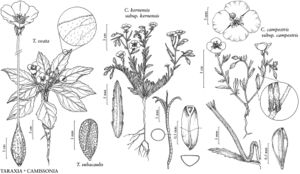familyOnagraceae
subfamilyOnagraceae subfam. Onagroideae
genusCamissonia
speciesCamissonia kernensis
subspeciesCamissonia kernensis subsp. kernensis
Difference between revisions of "Camissonia kernensis subsp. kernensis"
Treatment appears in FNA Volume 10.
imported>Volume Importer |
imported>Volume Importer |
||
| Line 42: | Line 42: | ||
|publication year= | |publication year= | ||
|special status= | |special status= | ||
| − | |source xml=https://xjsachs2@bitbucket.org/aafc-mbb/fna-data-curation.git/src/ | + | |source xml=https://xjsachs2@bitbucket.org/aafc-mbb/fna-data-curation.git/src/e39f0e846f172941159b2045254d62d10d9823f6/coarse_grained_fna_xml/V10/V10_567.xml |
|subfamily=Onagraceae subfam. Onagroideae | |subfamily=Onagraceae subfam. Onagroideae | ||
|tribe=Onagraceae tribe Onagreae | |tribe=Onagraceae tribe Onagreae | ||
Latest revision as of 10:32, 9 May 2022
Herbs compact, villous throughout and sparsely glandular puberulent. Stems 5–15(–22) cm. Leaves: proximalmost often clustered near base. Capsules: pedicel 3–15 mm. 2n = 14.
Phenology: Flowering Mar–Jul.
Habitat: Sandy slopes, flats, often with Artemisia tridentata and Yucca brevifolia.
Elevation: 700–2100 m.
Discussion
Subspecies kernensis is known only from northeastern Kern County where it is sometimes locally abundant.
Selected References
None.
Lower Taxa
None.
